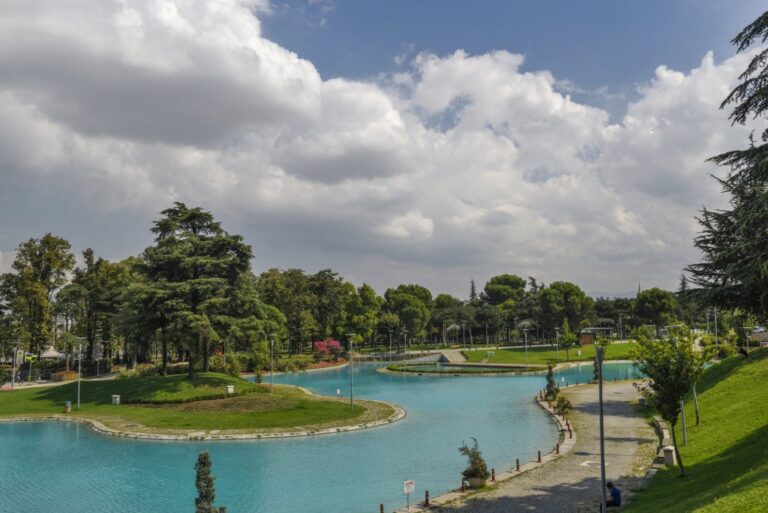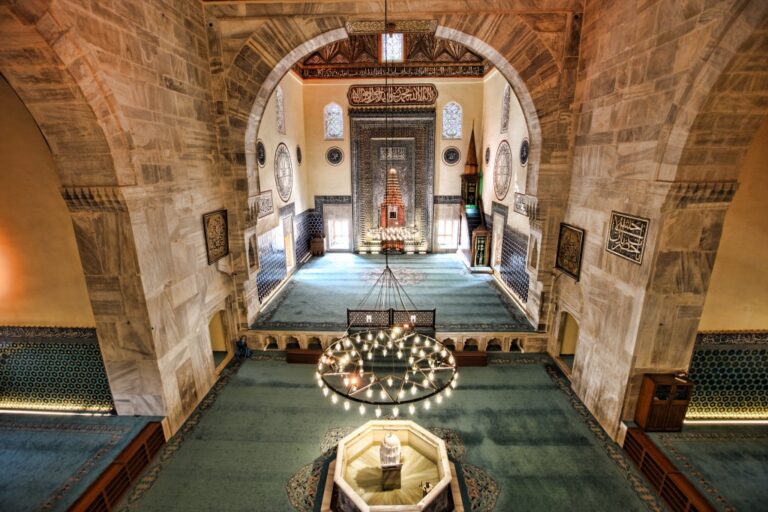9 Top-Rated Attractions & Things to Do in Bursa, Turkey
When traveling in Turkey, Bursa is a must-visit destination.
Bursa, as one of the most important historical cities of Turkey, with its rich history and breathtaking natural beauty, offers a truly immersive experience for every visitor. Known as “Green Bursa”, this enchanting destination was once the first capital city of the mighty Ottoman Empire and continues to exude the grandeur and charm of its imperial past. Even though the Ottoman capital moved to Edirne in 1363, the enduring significance of Bursa to the empire is evident in the multitude of structures that have persevered over time, serving as a testament to its enduring importance.
Steeped in history, Bursa city boasts an abundance of architectural wonders that transport you back in time. As you explore the city, you’ll be captivated by the magnificent mosques, towering minarets, and historical bazaars that showcase the splendor of Ottoman architecture.
Beyond its architectural marvels, Bursa is renowned for its lush landscapes and natural wonders. Nestled at the foot of the towering Uludağ Mountain, the city of Bursa is a gateway to breathtaking natural beauty. During winter, Uludağ transforms into a vibrant ski resort, attracting winter sports enthusiasts from around the world. In spring, the mountain becomes a hiker’s paradise, offering stunning panoramic views of the surrounding countryside.
Bursa’s exceptional blend of history and nature has earned it a place on the UNESCO World Heritage List. Visitors can explore the historic areas of Bursa and witness the fusion of Ottoman and Byzantine rule influences that shaped this remarkable city.
As you wander through the bustling streets of Bursa city, you’ll be enticed by the vibrant bazaars and traditional Turkish cuisine. Indulge in the Iskender Kebab, most famous kebab dishes of Turkiye, a delectable local dish that will tantalize your taste buds, or savor the sweet delight of candied chestnuts, a specialty of the restaurants in the region.
Whether you’re a history buff, nature lover, or simply seeking an immersive cultural experience, Bursa has something to offer every visitor. From its UNESCO-listed sites to its stunning natural landscapes, this city is a treasure trove of wonders waiting to be discovered.
Immerse yourself in the vibrant tapestry of Bursa’s past and present, and create unforgettable memories in this remarkable Turkish gem.
If you have a plan visiting Bursa in Turkey, here are the top attractions and experiences that you shouldn’t miss out on!
1. Explore the Grand Mosque of Bursa (Ulu Cami)
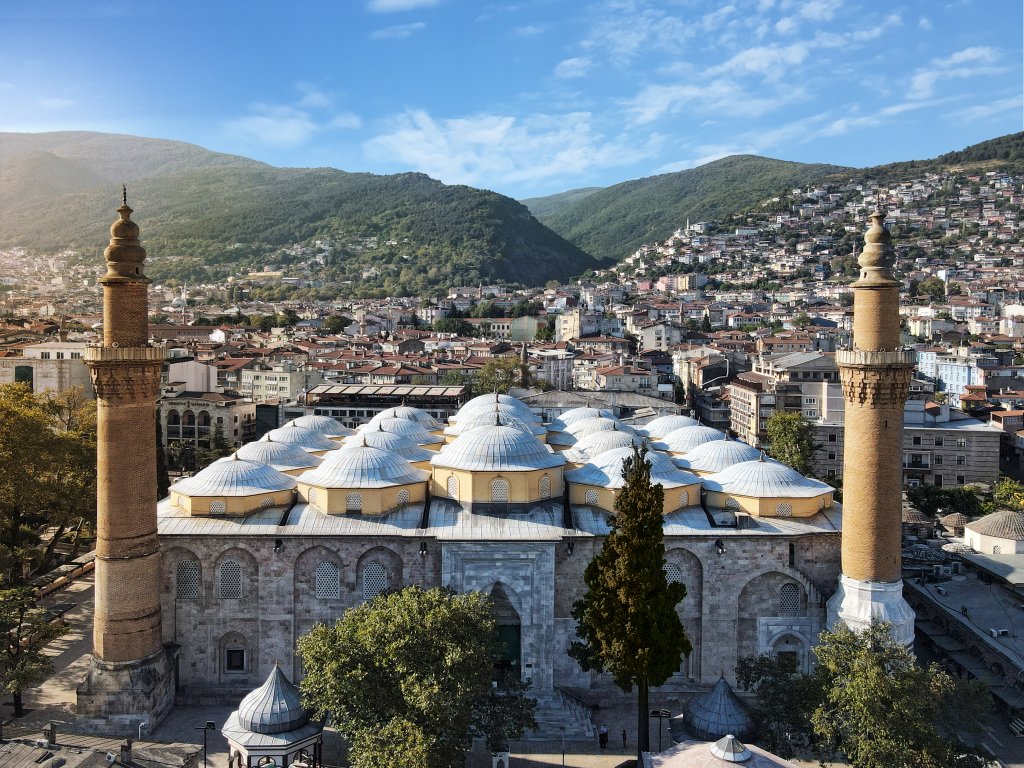
Ulu Cami, also known as the Great Mosque, was commissioned by Yıldırım Bayezid (Ottoman Sultan) and constructed between 1396 and 1399 in Bursa, Turkey. Originally, Bayezid intended to build 20 small mosques in Bursa after his victory in the Battle of Nicopolis in 1396. However, on the recommendation of his son-in-law, Emir Sultan, who was a prominent scholar of the time, he decided to build the grand Ulu Cami with its 20 domes. While the exact architect is unknown, some sources suggest the name Ali Neccar.
Ulu Cami stands as the largest example of multi-domed mosque architecture in the Ottoman Empire. It holds significant religious importance and is considered the 5th holiest site in Islam, after Mecca, Medina, Jerusalem, and Damascus, according to the scholars of the time. The mosque has three entrances on its east, west, and north facades. The crown gate on the north facade, made of marble, is particularly magnificent.
The Grand Mosque is characterized by thick walls and 12 square-plan load-bearing piers connected by arches, supporting 20 domes with an 11-meter diameter each. The central dome is covered with glass and underneath it, there is a large 16-sided ablution fountain.
Inside the Grand Mosque, there are 129 inscriptions attributed to famous calligraphers such as Abdülfettah Efendi, Kazasker Mustafa İzzet Efendi, Sami Efendi, and Şefik Efendi. These inscriptions are regarded as exemplary works of calligraphy. Examples from the 99 names of Allah are written on each face of the piers in Thuluth and Kufic scripts. Additionally, there is a plaque belonging to Sultan Mahmud II in the mosque.
The pulpit (minber) of the mosque is a masterpiece of woodworking craftsmanship. It is made without nails or any other binding material and consists of interlocking parts. It was created by Hacı Muhammed bin Abdülaziz bin İbnü’d-Devâkî. The eastern face of the pulpit depicts the solar system, while the western face depicts the Milky Way galaxy. A inscription on the door of the pulpit indicates that it was completed in 1399, during the reign of Yıldırım Bayezid.
The Grand Mosque has two minarets, constructed with marble bases and brick shafts, located at the corners of the north facade.
Finally, the mosque underwent restoration work between 2008 and 2010.
Ulu Cami is located in the heart of the city’s historical district in central Bursa. It is situated in the neighborhood of Osmangazi, specifically in the Ulu Cami Mahallesi (Grand Mosque Quarter). The mosque’s central location makes it easily accessible and a prominent landmark in Bursa City.
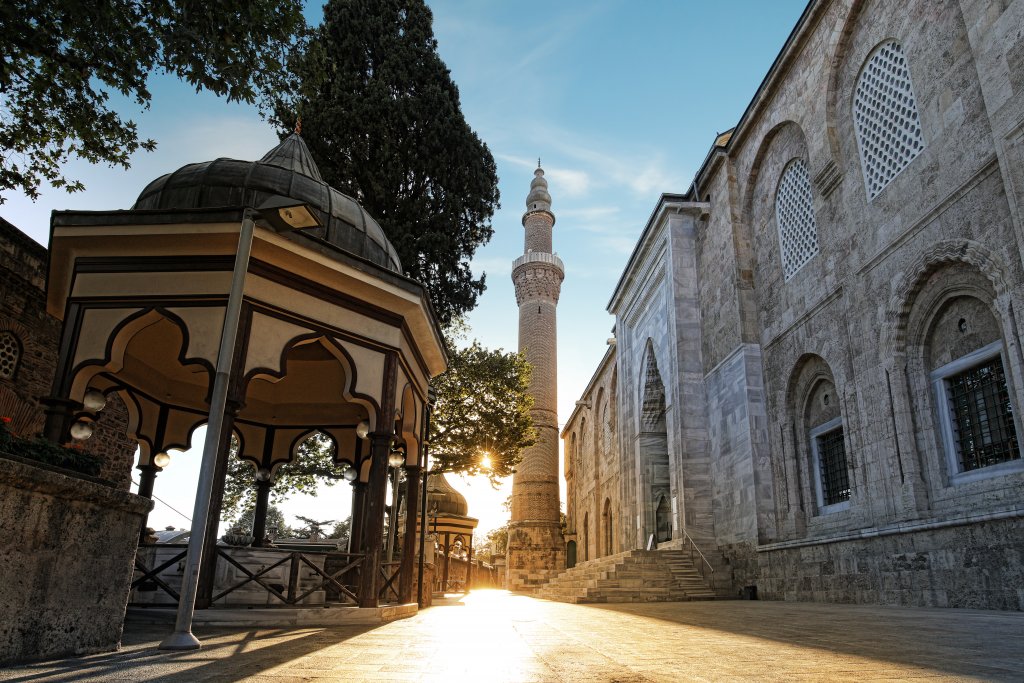
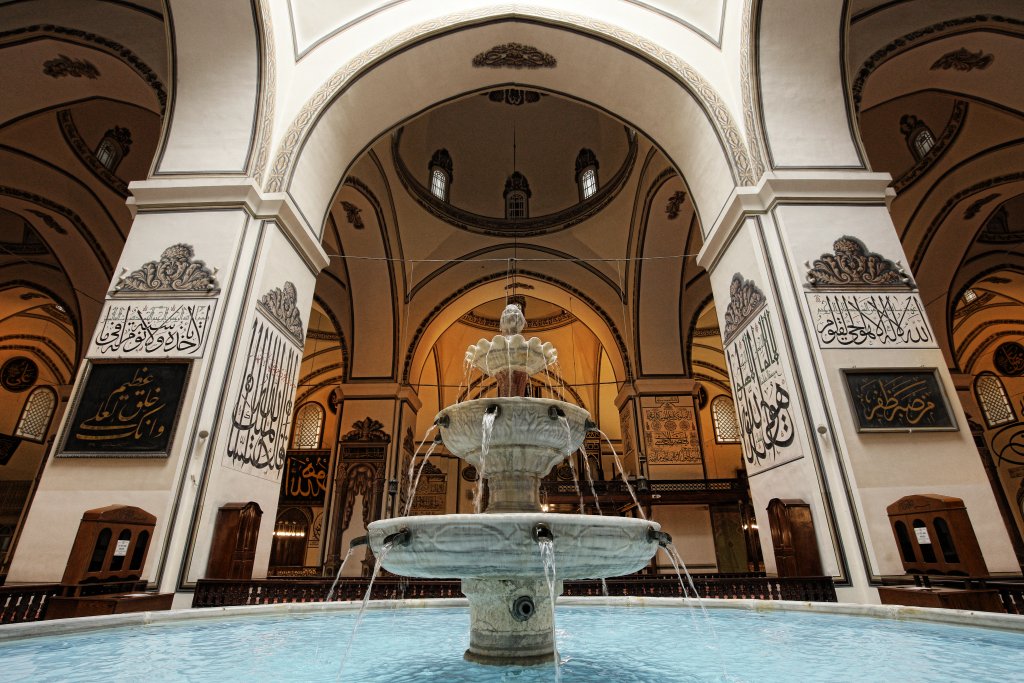
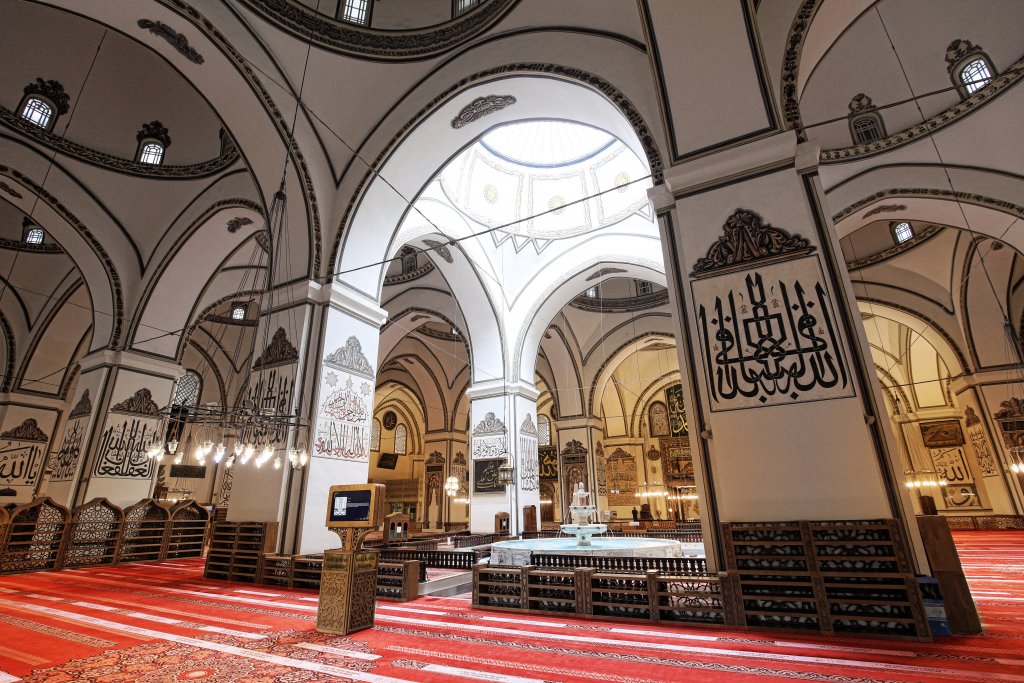
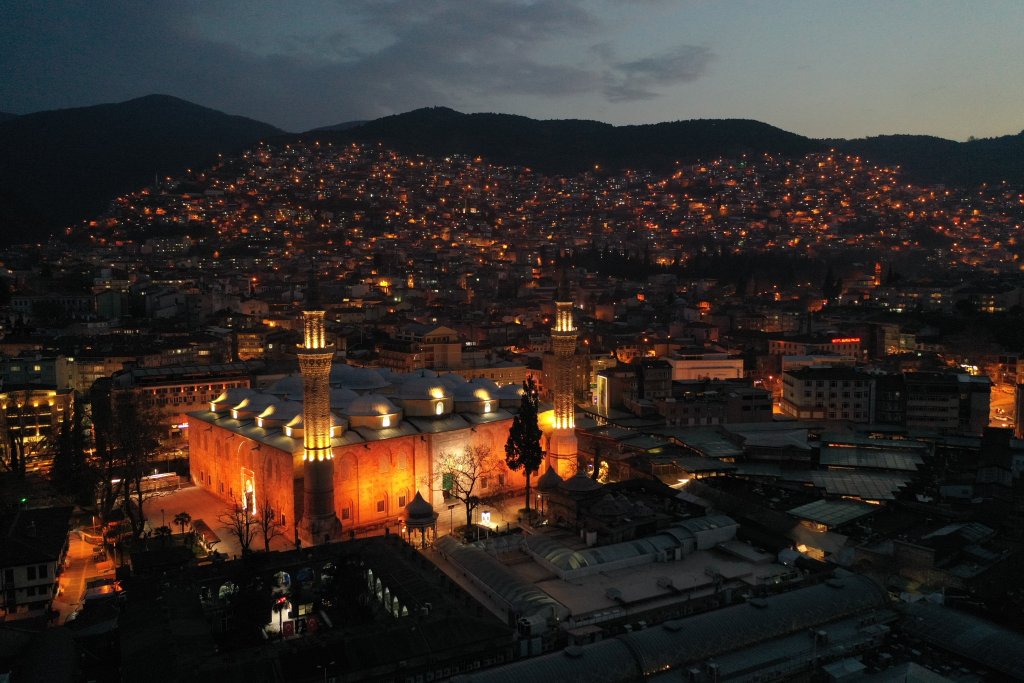
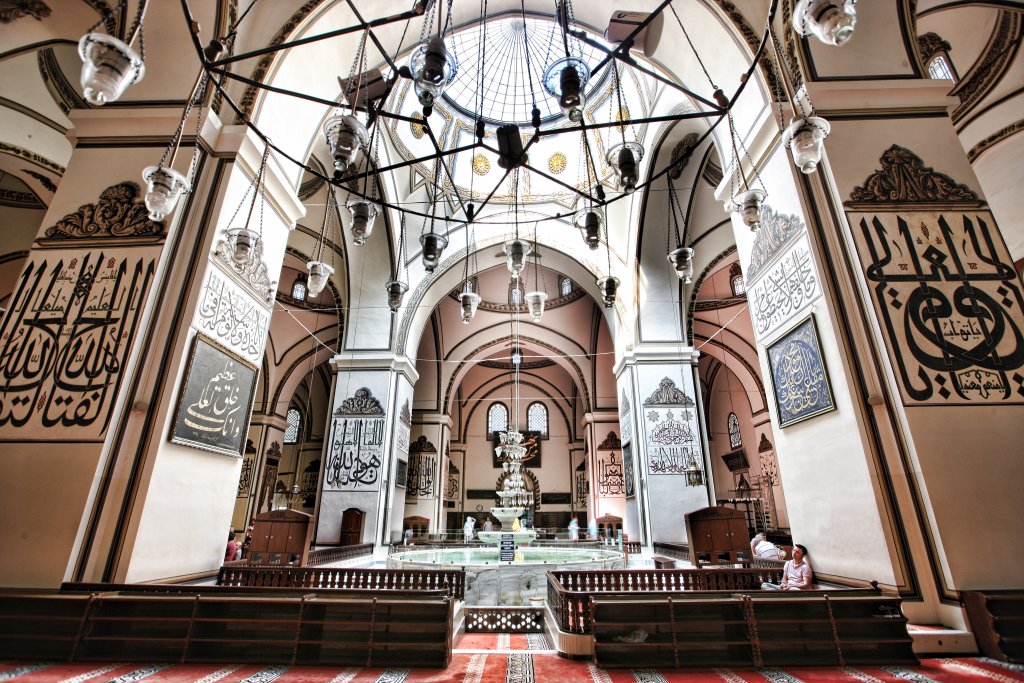
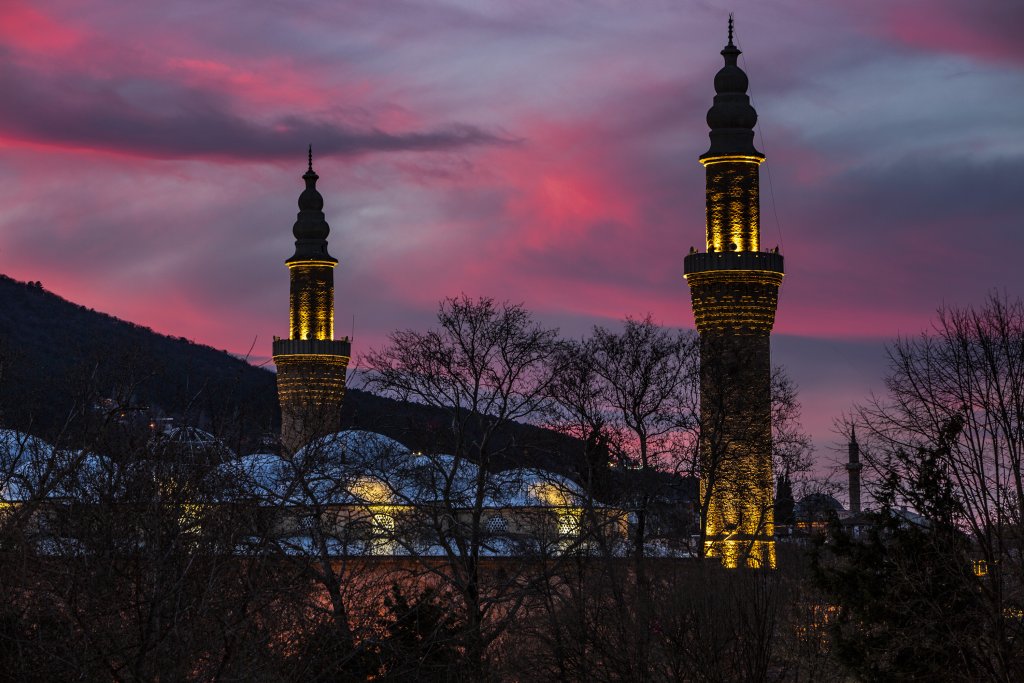
How to visit the Grand Mosque
Opening Hours:
The Grand Mosque is open to visitors throughout the week, from morning until evening. It is an active place of worship, and daily prayers are held here. Be aware of the prayer times and try to plan your visit accordingly. During prayer times, maintain a respectful distance from worshippers and avoid walking in front of them.
Dress Code:
As a place of worship, it is important to dress modestly when visiting the Mosque. Both men and women should cover their shoulders and legs. Women are also required to cover their heads with a scarf. It is recommended to wear comfortable shoes as you may need to remove them before entering the prayer area.
Mosque Etiquette:
Ulu Cami is an active religious site, so it’s important to maintain a respectful demeanor during your visit. Keep your voice low and avoid any disruptive behavior. If prayers are taking place, it is customary to observe from a respectful distance and not to walk in front of worshippers.
Guided Tours:
If available, consider joining a guided tour of the Ulu Cami. These tours can provide valuable insights into the history, architecture, and significance of the mosque. Check with the mosque authorities or local tourism offices for information on guided tours and their schedules.
Photography:
Photography is generally permitted inside the mosque, but it is essential to be mindful of the worshippers and the sanctity of the space. Respect any signage or instructions regarding photography restrictions or areas where photography is not allowed.
Religious Services:
Ulu Cami is an active place of worship, and daily prayers are held here. If you visit during prayer times, you may witness the congregational prayers and experience the spiritual atmosphere of the mosque. However, be mindful not to disturb worshippers during their prayers.
Surrounding Area:
The Grand Mosque is located in the heart of Bursa’s historic city center, surrounded by other notable landmarks, traditional markets, and cultural sites. Take the opportunity to explore the surrounding area and immerse yourself in the rich history and culture of Bursa.
2. Visit the Mosque and Kulliye of Orhan
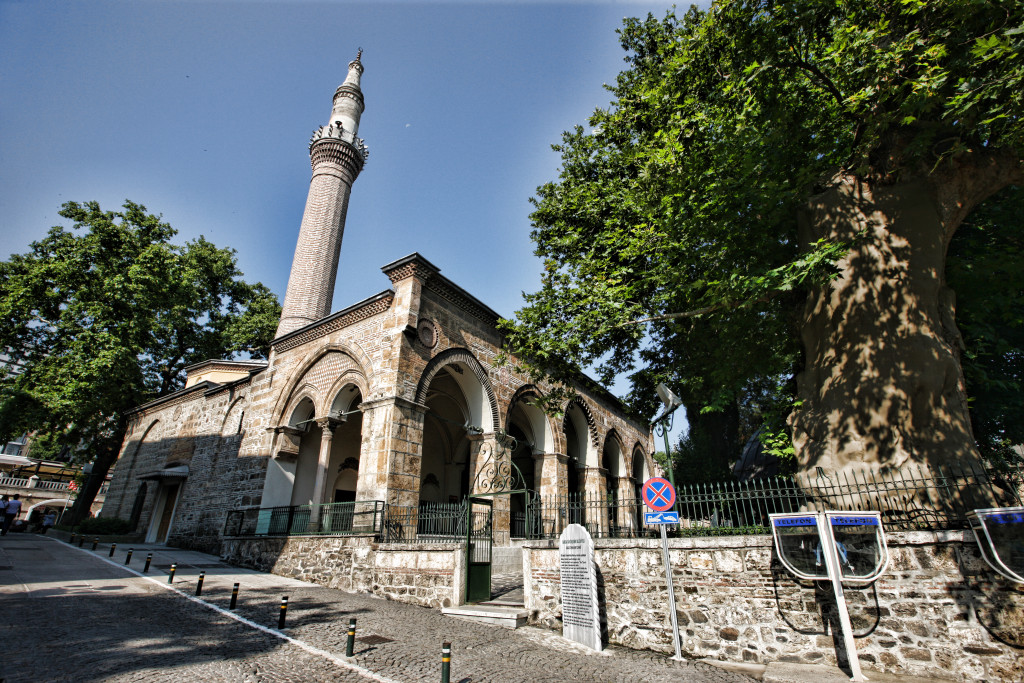
The central structure of the Orhan Külliyesi, the mosque, was commissioned by Orhan Bey and built in 1339. It is the first building constructed outside the city walls after the conquest of Bursa, Turkey. This early Ottoman architectural masterpiece is the first mosque in Bursa with a unique reverse “T” plan (with rooms and corners).
The prominent features of the mosque include high pointed arches made of brick and stone, brick sun courses, and rosettes on the facades. The side facades of the mosque’s outer courtyard feature column capitals from the Byzantine era. According to legend, the popular Turkish shadow play characters, Hacivat and Karagöz, were believed to have worked as craftsmen during the construction of Orhan Mosque.
The structure is located within the area declared a UNESCO World Heritage Site in 2014, recognizing its cultural and historical significance.
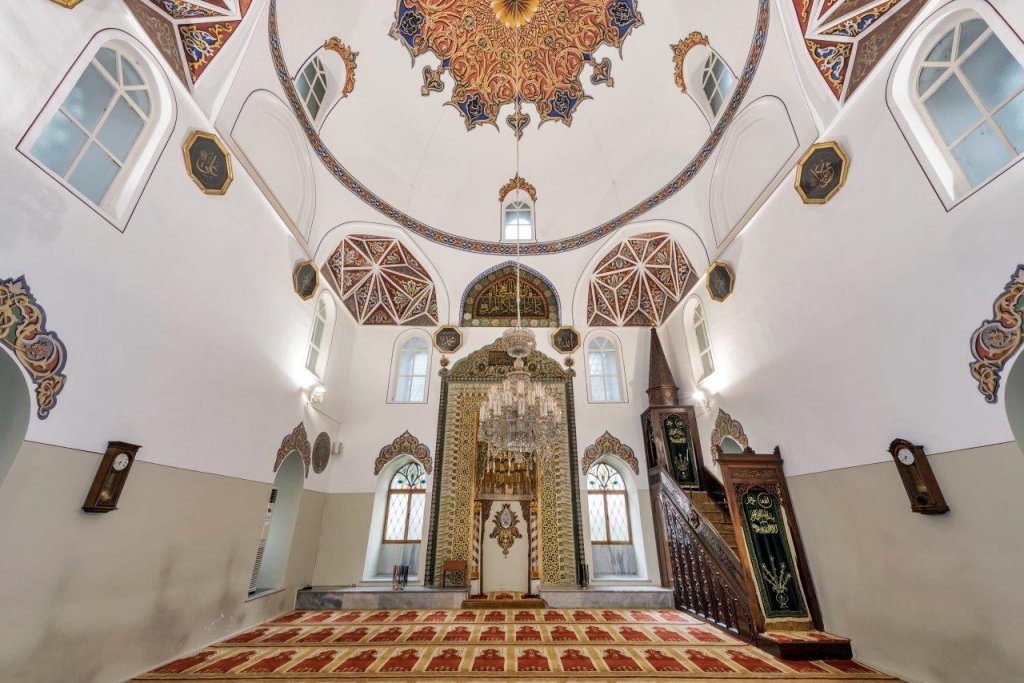


3. Do Shopping in the Koza Han Silk Bazaar
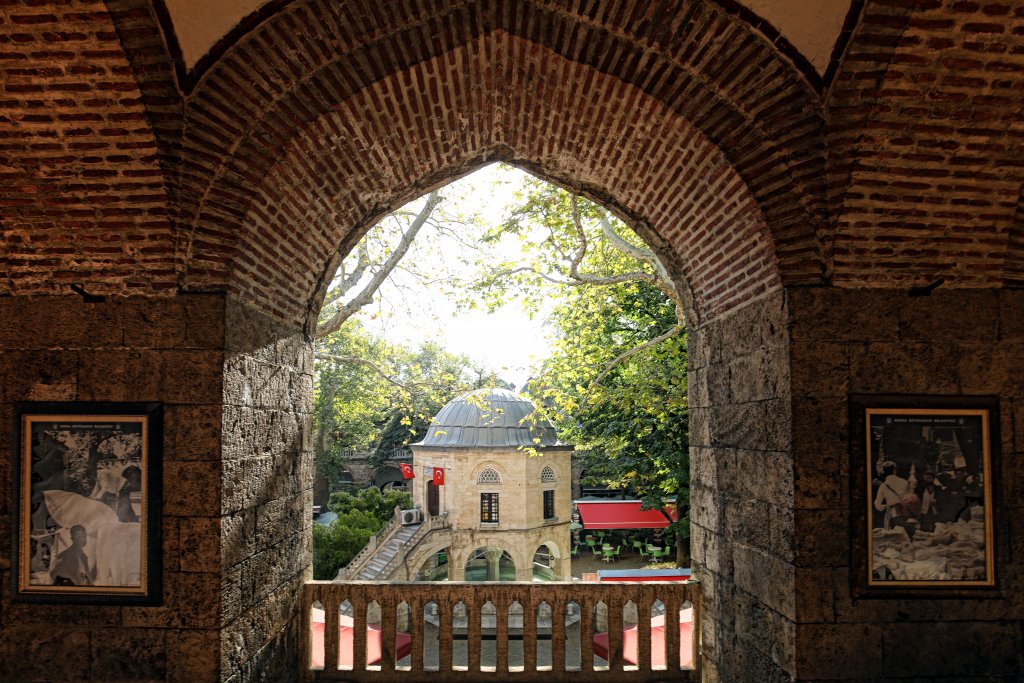
Koza Han was built in Bursa, Turkey by Sultan Bayezid II in order to generate income for his mosque and medrese in Istanbul. Construction began in March 1489 and was completed on September 30, 1491, opening for service. The architect of the han is Abdülûlâ bin Pulad Şah.
Koza Han has been known by various names such as Yeni Han, Beylik Han, Hān-ı Cedīd-i Āmire, Hān-ı Cedīd-i Evvel, Simkeş, Sırmakeş, Beylik Kārbānsaray, and Eski Yeni Han.
The han follows a classical plan and consists of a two-story main building surrounding a rectangular courtyard that is almost square-shaped, and an adjacent single-story courtyard structure known as İç Koza Han, which houses stables and storage rooms.
The han has three entrances, with a magnificent gate on the northern facade. In the center of the inner courtyard, there is a fountain and a small mosque.
Being built on the same axis as the Orhan Mosque and Emir Han, which contributed to the city’s expansion, Koza Han indicates the continuity of commercial support. As the last destination on the Silk Road, Koza Han played a crucial role in the silk trade between Asia and Europe. For centuries, Koza Han has been an international trading and shopping center. It has hosted merchants from different countries and nations. Even today, it maintains its commercial vibrancy.
Koza Han is located within the city center of Bursa.
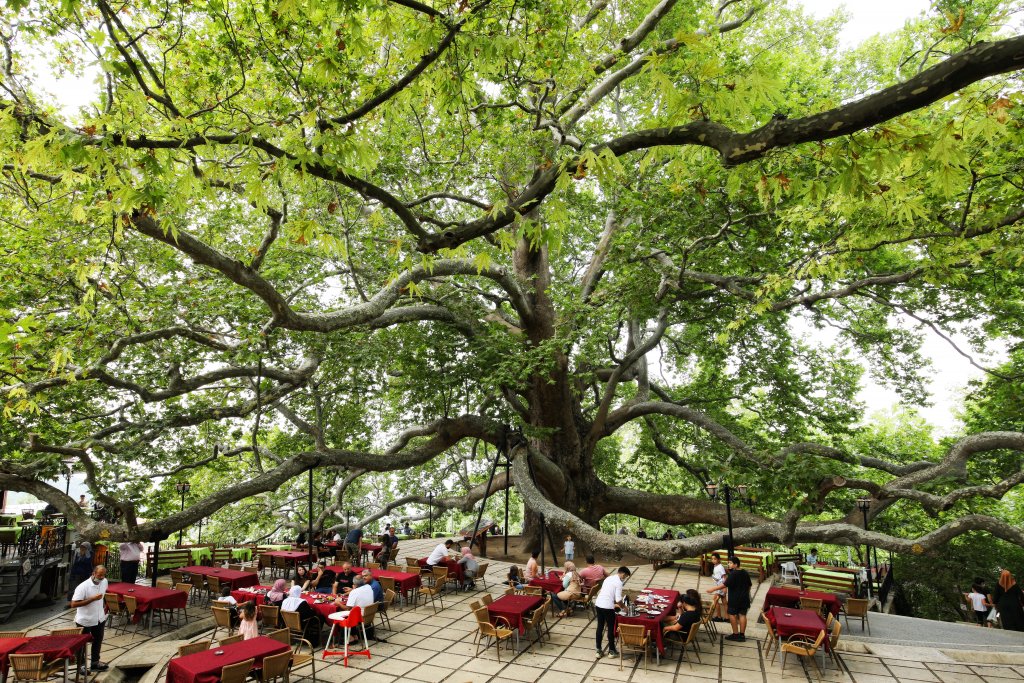
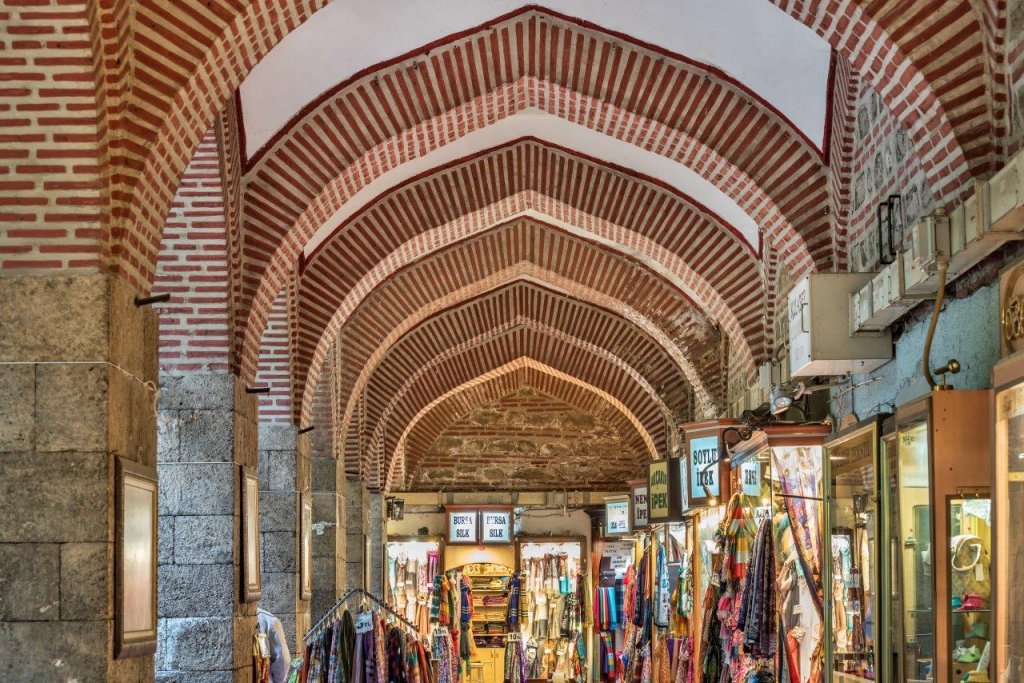

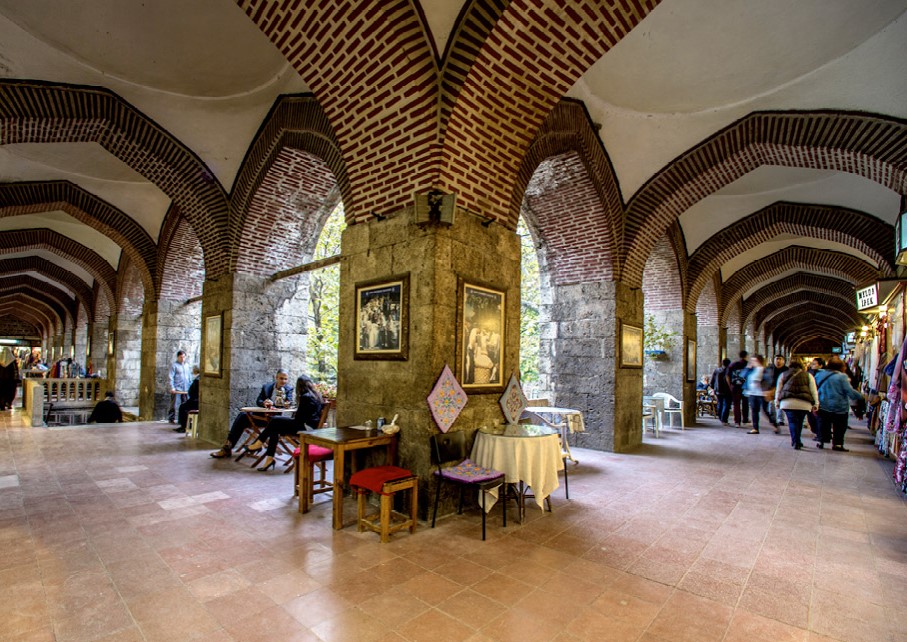
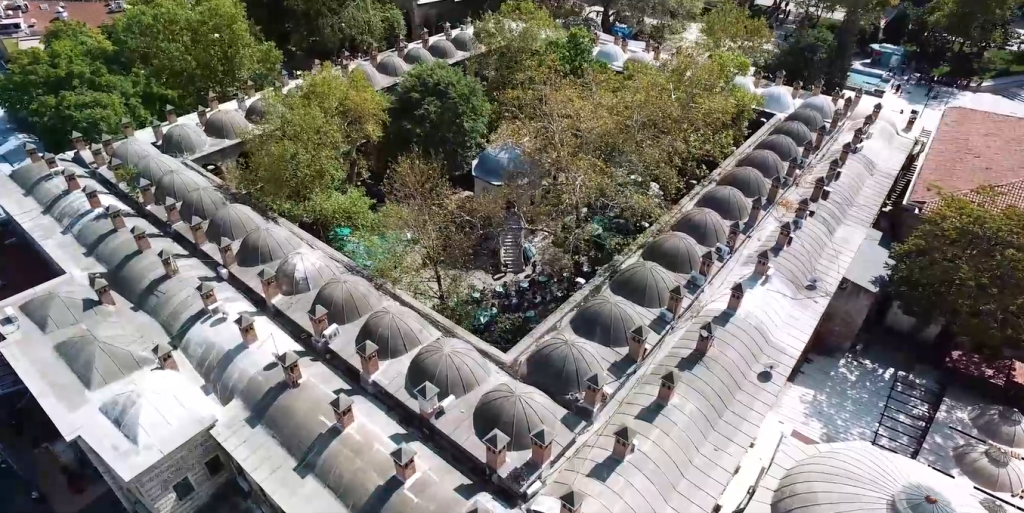

After visiting this historical bazaar, you may continue shopping in the Grand Bazaar.
The Covered Market in Bursa City, also referred to as Kapalı Çarşı, is located in central Bursa, near Emir Han and offers a variety of shops, particularly jewelry stores. It provides a vibrant shopping experience and an opportunity to explore local craftsmanship.
If you are interested in exploring Bursa’s traditional markets and experiencing its local culture, a visit to the Covered Market after Koza Han can be a worthwhile addition to your itinerary. You can immerse yourself in the lively atmosphere, browse through various shops, and find unique items to purchase. Just keep in mind that it is not the same as the famous Grand Bazaar in Istanbul, but it still offers its own charm and local flavor.
As you are in the home town of Iskender Kebap, make sure to savor the iconic Turkey’s Iskender Kebap, a culinary masterpiece that originated in this vibrant city. Head to one of the renowned local restaurants, such as the historic İskender Restaurant, and indulge in this delectable dish featuring tender slices of lamb or beef, served over a bed of bread and smothered with rich tomato sauce and melted butter. Don’t forget to top it off with a dollop of tangy yogurt for the perfect balance of flavors. Your taste buds will thank you for this authentic Bursa city experience!
4. Discover the Historic Marvel: Irgandı Bridge
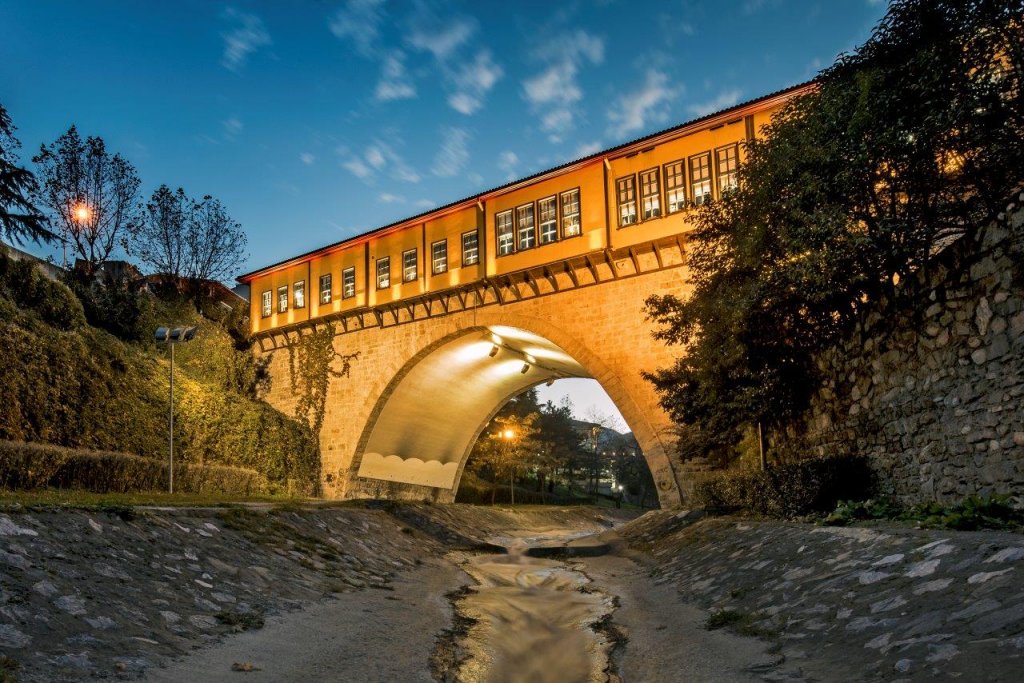
Irgandı Bridge of Bursa City, also known as Irgandı Köprüsü, was constructed during the reign of Sultan Murad II in 1442. It was built by Hoca Muslihuddin, son of Ali, who was an important merchant of the time and sold silk from Azerbaijan to Italian traders. During the 15th century, Bursa was a significant trading center, and as part of the urban development activities, merchants also constructed commercial structures. Irgandı Bridge, with its arasta (market) on top and stables and warehouses within its main structure, is one of those buildings. The architect of the bridge is known as Abdullah, son of Timurtaş.
Irgandı Bridge is one of the four cross-shaped bridges in the world, along with Vecchio and Rialto Bridges in Italy and Osma Bridge in Bulgaria.
Located over the Gök River, it is the third bridge connecting the eastern part of the city to its center.
During its initial construction, the bridge was made of masonry and consisted of 31 shops in total, with 16 sections on each side. It also included a mosque and storage and stable areas at the base of its arches.
Today, the main structure of the bridge consists of a 16-meter wide and 11-meter high arch, with vaulted interior spaces on either side of the arch. The 18 shops in the market are constructed using a wooden skeleton system, extending towards the Gök River with supported bay windows, and some have storage rooms underneath.
In the second half of the 19th century, Irgandı Bridge transformed into an open-air market with wooden shops lined up together. In 1922, when the occupying forces left Bursa, they bombed and destroyed the bridge. It was reconstructed without the market as a reinforced concrete structure in 1949.
In 2004, the bridge underwent reconstruction to restore its original form.

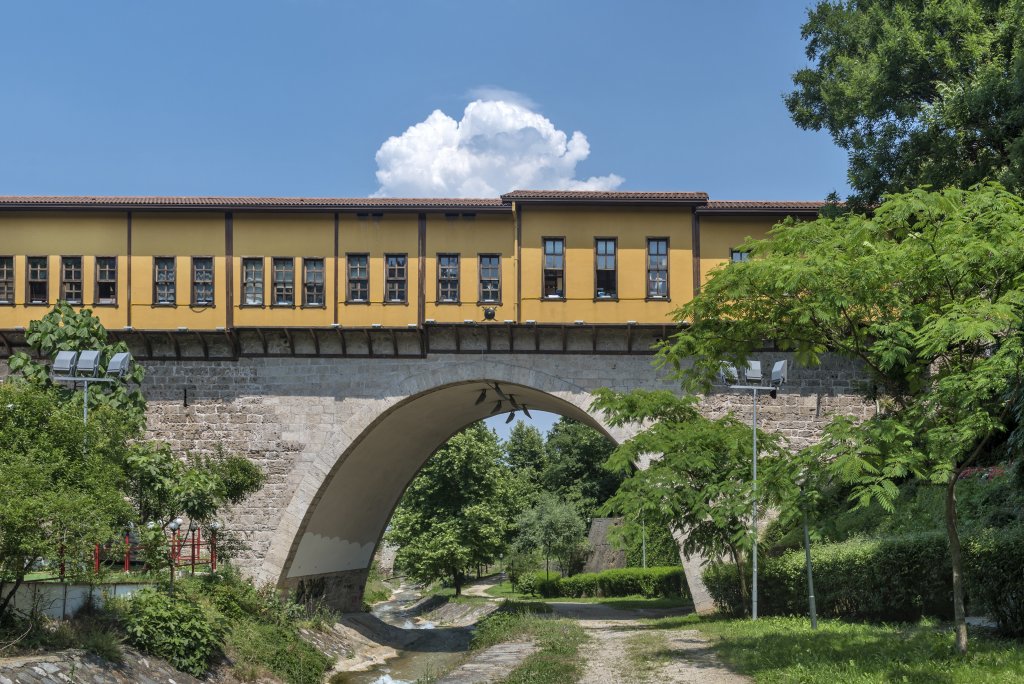
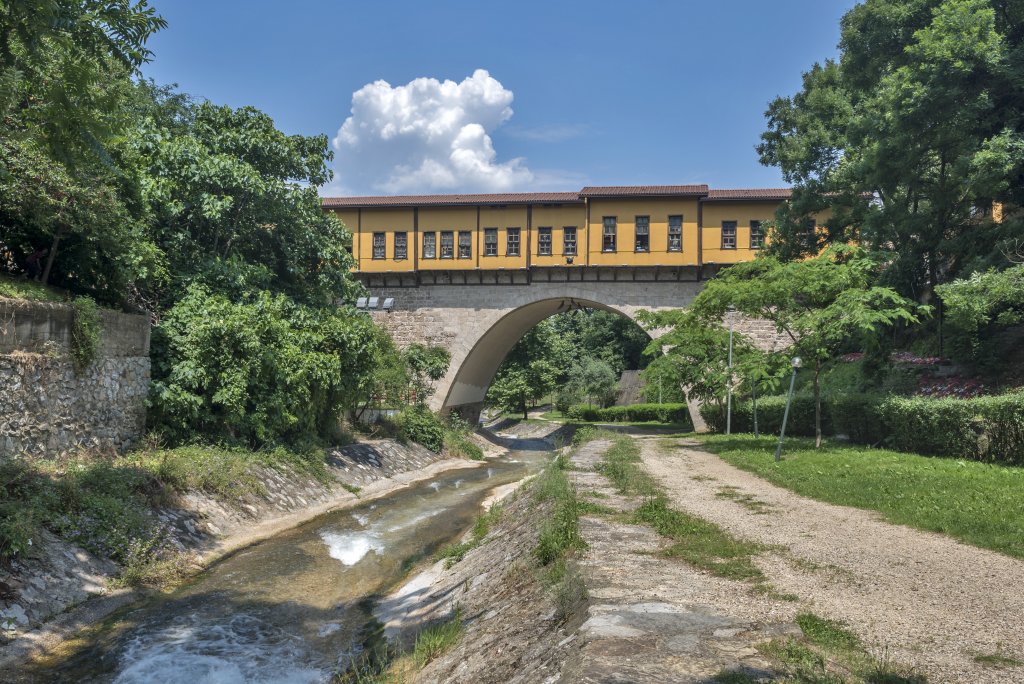
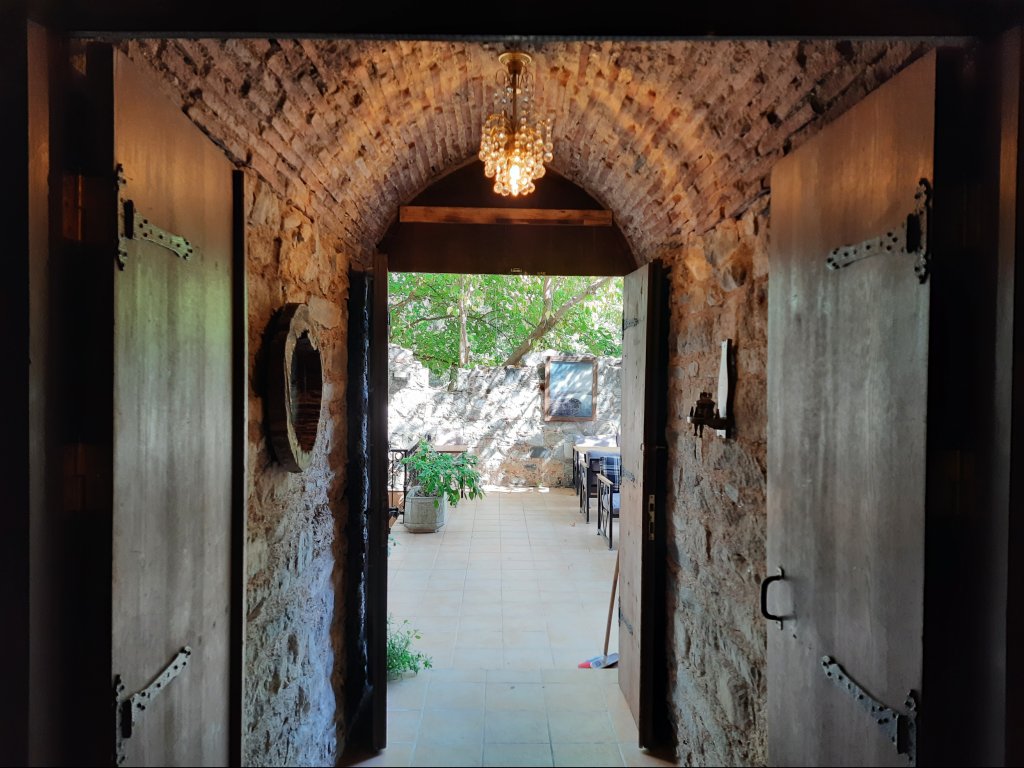
5. Visit the Green Mosque and Green Tomb
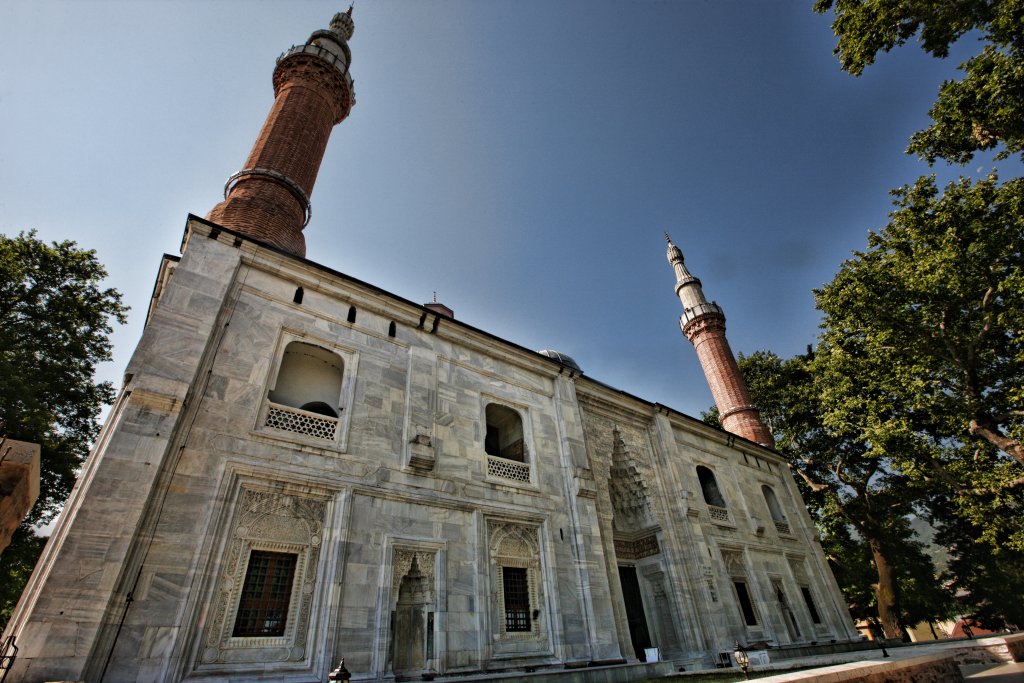
If you are planning to visit Bursa City, exploring the Green Mosque (Yeşil Cami) should definitely be on your itinerary.
The Green Mosque, built between 1419 and 1420 by Sultan Mehmed I in Bursa, Turkey. It is a symbol of the revival of the Ottoman Empire after the period of turmoil following the Battle of Ankara.
Designed by the architect Haci Ivaz Pasha, the mosque follows a symmetrical plan and features exquisite decorative elements such as calligraphy, geometric and floral motifs, and ceramic tile work.
The entrance leads to a grand hall with cross-vaulted rooms on either side, and a staircase leads to the upper floor with a royal lodge and chambers. The main prayer hall is accessed through a transitional corridor and features mihrab niches and decorated domed rooms.
The meticulous craftsmanship and harmonious composition of the mosque’s exterior and interior decorations showcase the skill of its artisans.
The Green Mosque underwent restoration by the General Directorate of Foundations between 2010 and 2012. It is located in the city center of Bursa.
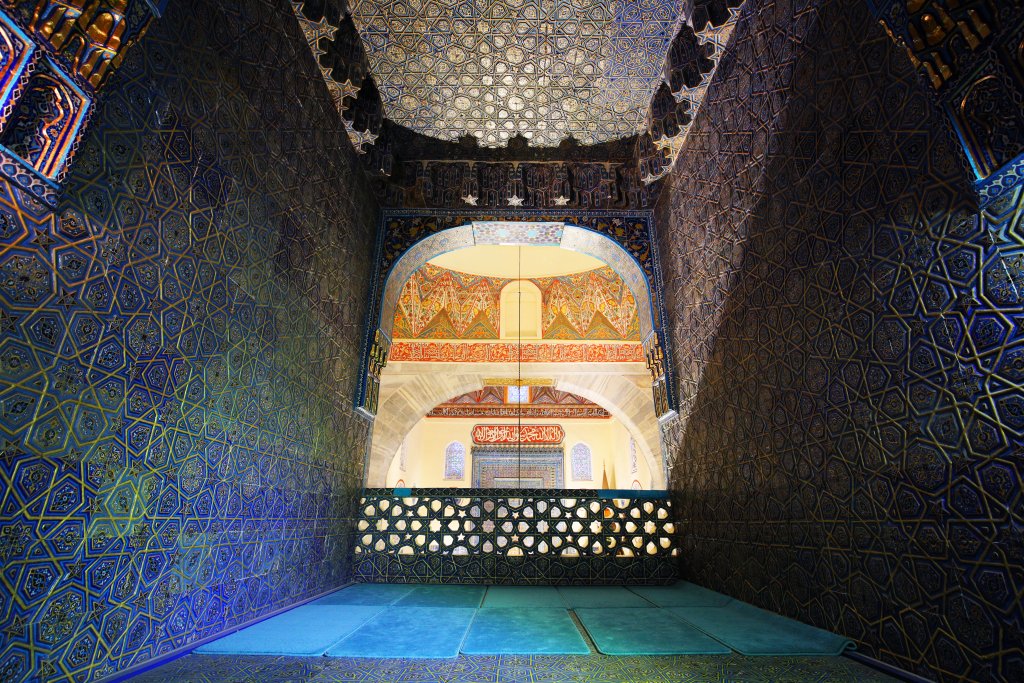

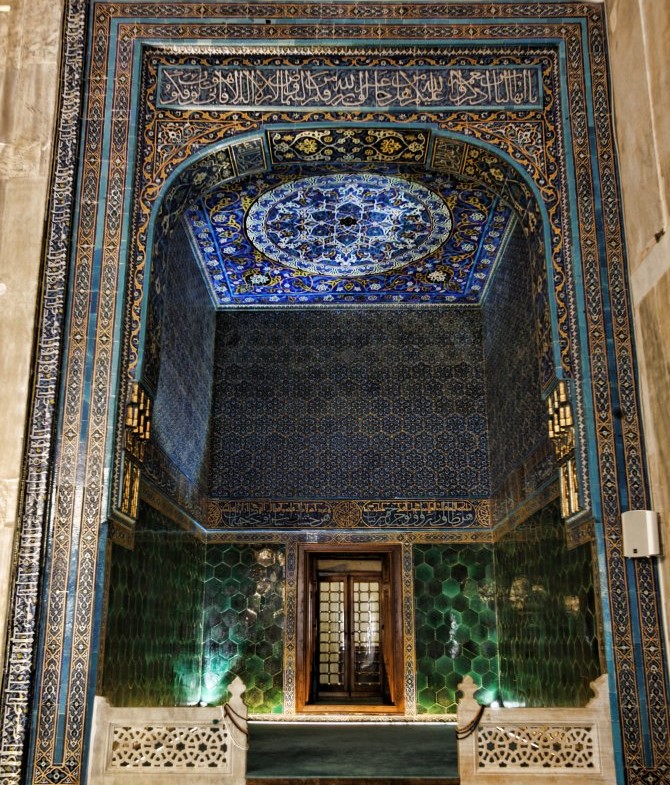


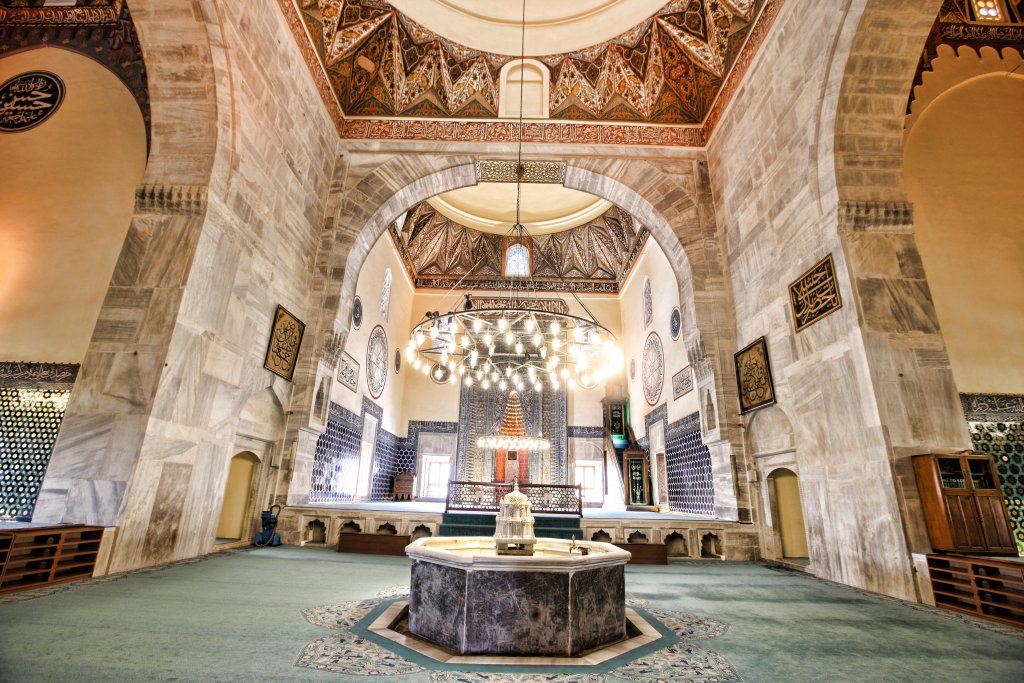
The Magnificent Green Tomb: A Masterpiece of Iznik Tile Artistry in Bursa City
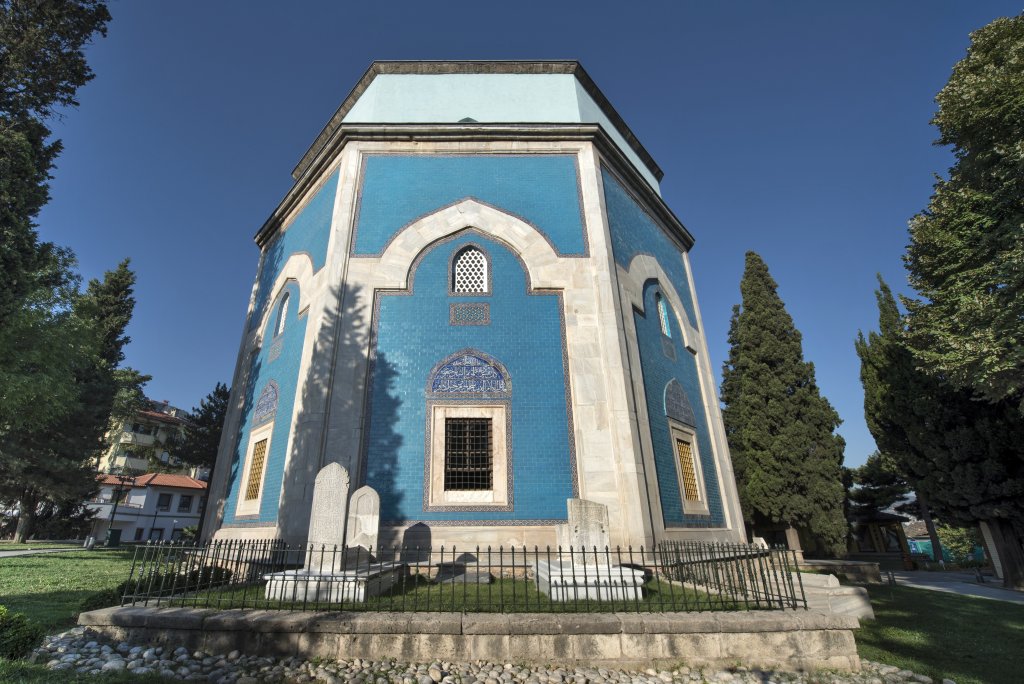
The Green Tomb, the most famous structure of the Green Complex, was commissioned by Sultan Mehmed I, an important figure in early Ottoman history, in 1421 and built by Haci Ivaz Pasha. It gets its name from the unique blue, green, and turquoise-colored Iznik tiles, known as “Impossible Ceramics,” used in its decoration.
The tomb, divided into five sections by walls and featuring a crypt (burial chamber), has an octagonal body. The exterior facades and window lintels are adorned with blue and white tiles inscribed with hadiths (sayings of Prophet Muhammad).
The wooden door of the tomb, created using the interlocking method (kündekâri), bears the inscription “Amel-i Hacı Ali bin Ahmed-i Tebrîzî,” indicating the master of woodwork in the complex. Other master craftsmen involved in the construction were Nakkaş Ali bin İlyas Ali and Mehmed el Mecnun.
Beautifully decorated interior walls of the tomb are covered with tiles up to a height of 3.00 meters. Each wall has two overlapping rectangular windows, and the dome’s pendentives feature one window each. The rectangular windows are surrounded by tile borders, and the pointed arch window lintels are inscribed with verses from the Quran and hadiths. The spaces between the windows feature “sâlbekli şemse” motifs.
The tomb houses nine sarcophagi. Sultan Mehmed’s sarcophagus and the mihrab (prayer niche) are adorned with embossed yellow, navy blue, and white tiles. The other sarcophagi belong to Sultan Mehmed’s sons Mustafa, Mahmud, Yusuf, and his daughters Selçuk, Sittî, Ayşe, Hafsa, as well as his wet nurse Dâye Hatun.
The Green Tomb underwent restoration between 2005 and 2009.
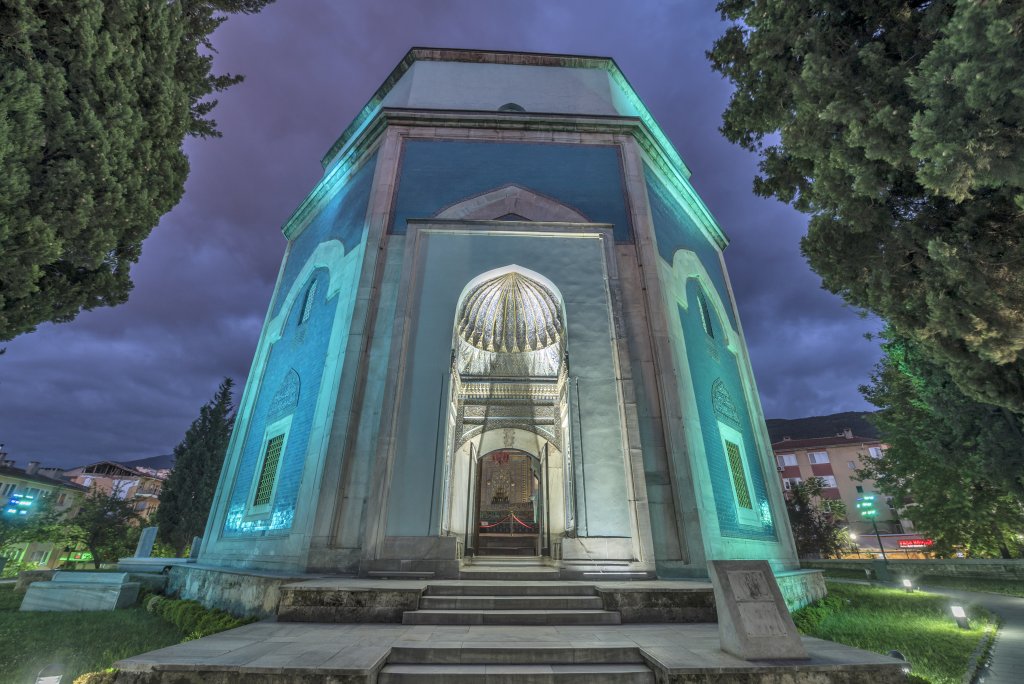

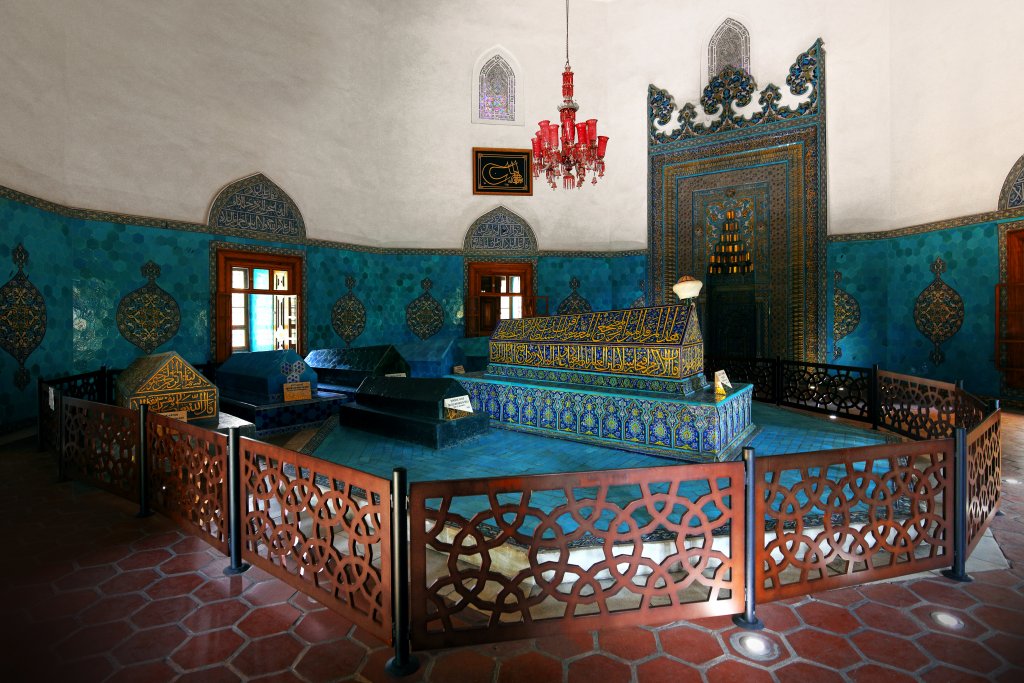
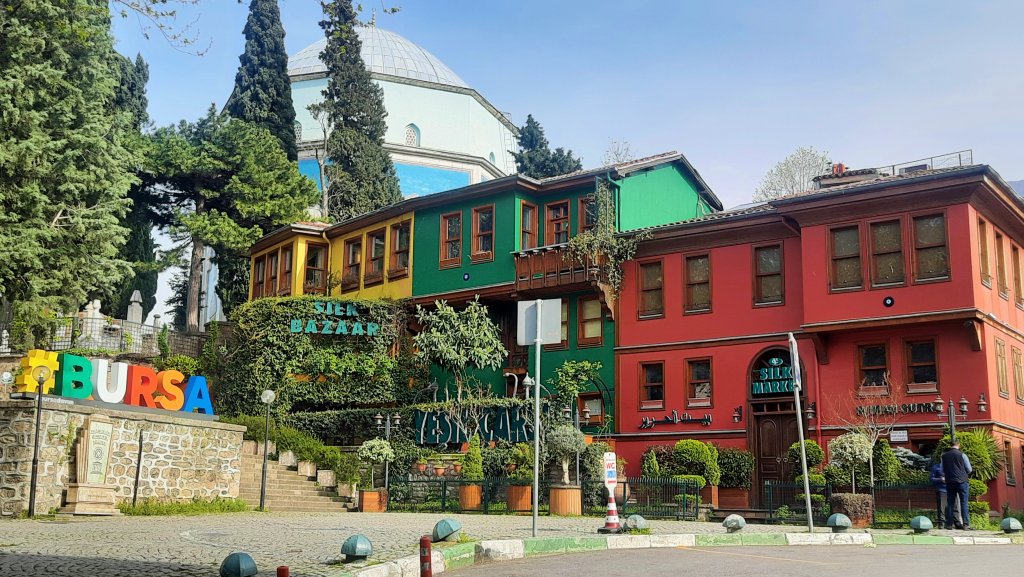


6. Experience the Breathtaking Cable Car Journey to Uludag Mountain of Green Bursa
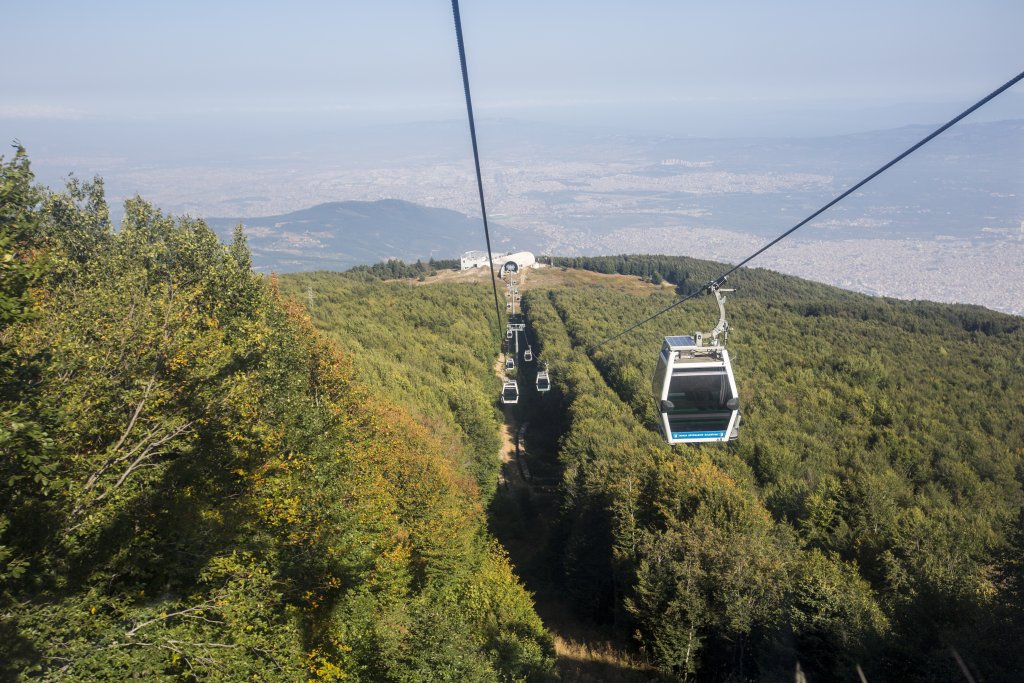
When you visit Bursa, one of the must-do activities is taking a thrilling cable car journey to Uludağ Mountain, where you can immerse yourself in the stunning natural beauty and enjoy a wide range of exciting things to do.
As one of the top tourist attraction in Green Bursa, the cable car ride up to Uludag Mountain offers a breathtaking and scenic journey. As you ascend, you’ll be treated to stunning panoramic views of the surrounding landscapes, including the city of Bursa and the picturesque countryside.
Bursa cable car system features modern and comfortable cabins, allowing you to relax and enjoy the ride. With a capacity of 1,500 passengers per hour, the cable car ensures a smooth and efficient transportation experience. The cabins are designed to minimize vibrations, providing a stable and pleasant journey even at higher altitudes.
The cable car’s upgraded technology and infrastructure guarantee a safe and secure trip. It is equipped with automated control systems, hydraulic doors, and a central electrical system, ensuring reliable operation and passenger comfort.
Whether you choose to ride during the day or at night, the cable car offers an unforgettable experience. You can enjoy the scenic beauty of the mountainous terrain, witness the changing landscapes, and immerse yourself in the tranquility of nature. Even in adverse weather conditions like rain or snow, the cable car continues to operate seamlessly, providing uninterrupted access to Uludağ Mountain.
For those seeking to add stunning mountain scenery to their city sightseeing itinerary, a cable car ride up to Uludağ Mountain is an absolute must-do in Bursa. It is also a must-try experience for nature lovers, adventure enthusiasts, and those seeking a unique perspective of Green Bursa’s picturesque surroundings.
Embark on an unforgettable day trip from Green Bursa and indulge in the breathtaking cable car journey to Uludağ Mountain, where you’ll be treated to awe-inspiring views and an enchanting natural landscape.
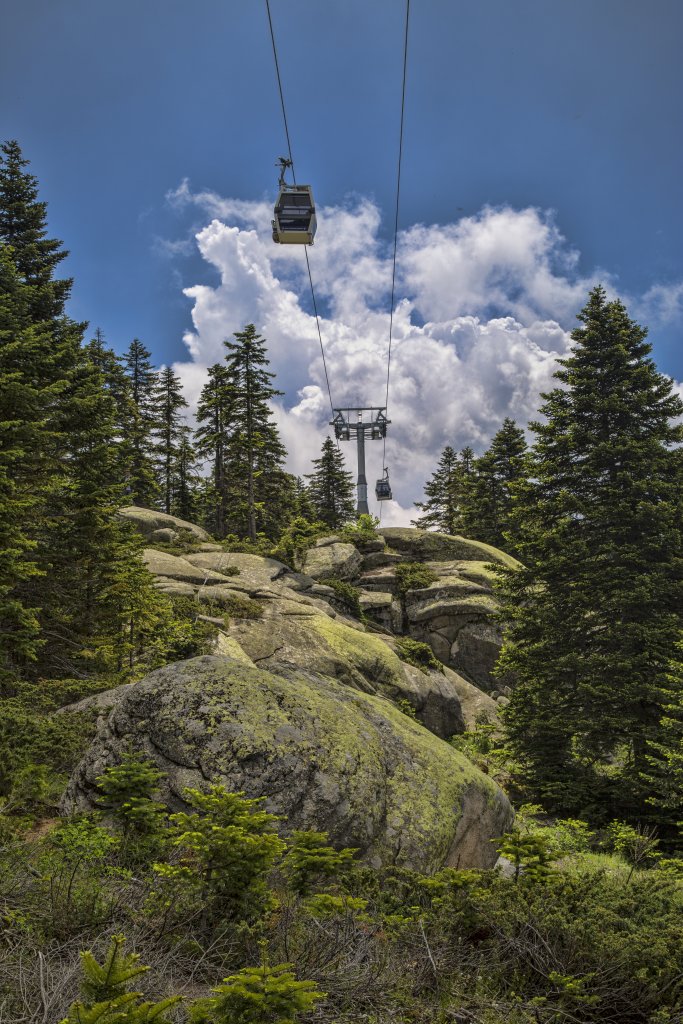
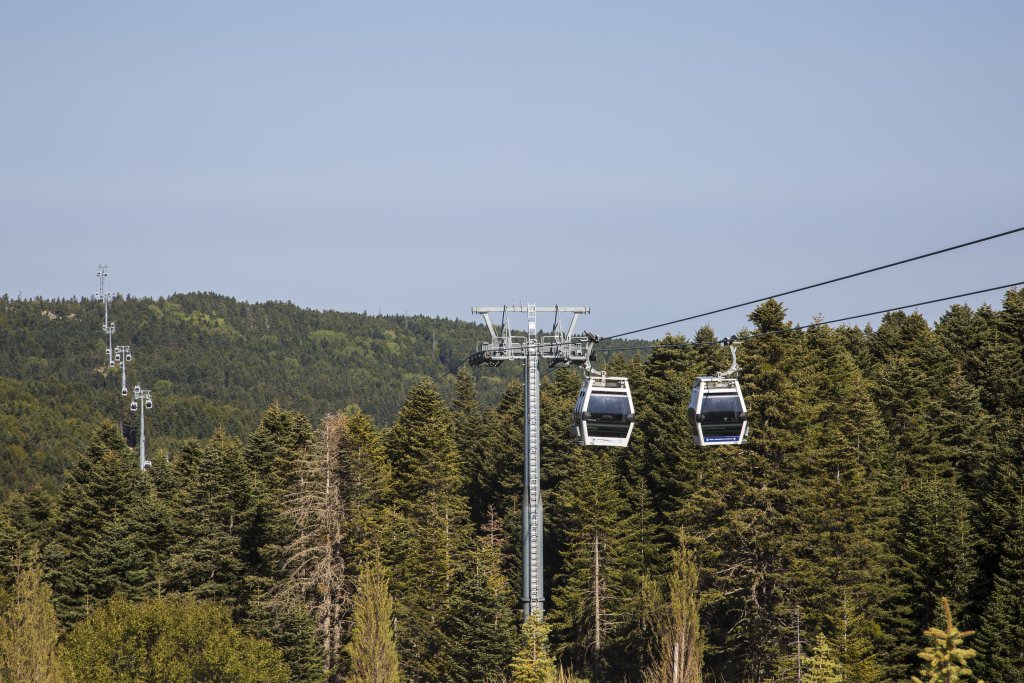

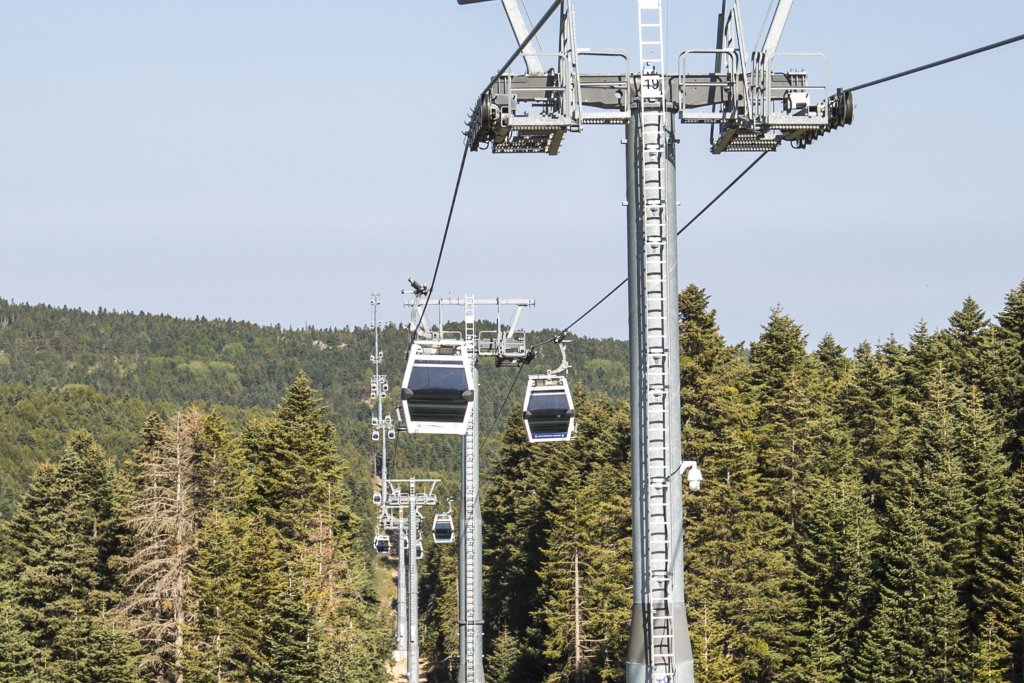
Nestled in the beautiful city of Bursa, Uludag Mountain offers a captivating blend of natural beauty and thrilling activities for visitors.
As one of the most popular tourist attractions in Turkey, it is renowned for its picturesque landscapes, lush forests, and breathtaking views. Besides its scenic charm, as a renowned popular ski resort, Uludag is a major winter sports destination, attracting winter sports enthusiasts from around the world. With its well-groomed slopes, modern facilities, and a variety of ski trails suitable for all levels, it promises an exhilarating experience for both beginners and advanced skiers. Whether you’re seeking outdoor adventure, stunning panoramas, or an adrenaline-fueled ski holiday, Uludag Mountain is the perfect destination to explore in Bursa.
7. Admire the Biggest Tree in Turkey: Inkaya, from the Ottoman Empire Era

When you visit Bursa, don’t miss the opportunity to admire the magnificent Inkaya (Ulu) Çınarı, which is the largest tree in Turkey.
Bursa is surrounded by ancient monumental trees that have stood the test of time. Among these trees, the most famous one is the Inkaya (Ulu) Plane Tree in Inkaya Village, located 4 km away from the Çekirge neighborhood on the road to Uludağ.
With over 600 years of age, this Plane Tree is physically the largest tree in Turkey, measuring 3 meters in diameter, 10 meters in circumference, and standing at a height of 37 meters.
Its thirteen main branches are as thick as the trunks of regular trees, making it a remarkable natural wonder to behold.
8. Visit the Hudavendigar Mosque

The Hüdavendigâr Mosque, located at the center of the Hüdavendigâr Complex, was commissioned by I. Murad, also known as Hüdavendigâr (means God’s Gift), in 1366. It is a unique example among Ottoman mosques as it combines a mosque and a madrasa within the same structure, designed in a two-story plan.
The architecture of the mosque stands out with its stone-brick decorations and pointed arches, incorporating Byzantine columns and capitals. It is known that Byzantine craftsmen also contributed to its construction.
The lower level consists of the entrance hall, outer courtyard, and a central single-domed space with six surrounding rooms. The central area features a 19th-century built ablution fountain.
Adjacent to the mosque’s entrance courtyard, there is a madrasa accessible via staircases. It accommodates four teachers (müderris), an assistant teacher (muîd), and twelve student cells. Renowned figures such as Molla Gürânî, Zenbilli Ali Efendi, and Tâcîzâde Cafer Çelebi, who later served as Sheikh ul-Islam, have taught as teachers in this madrasa.
This site is included in the UNESCO World Heritage List since 2014.
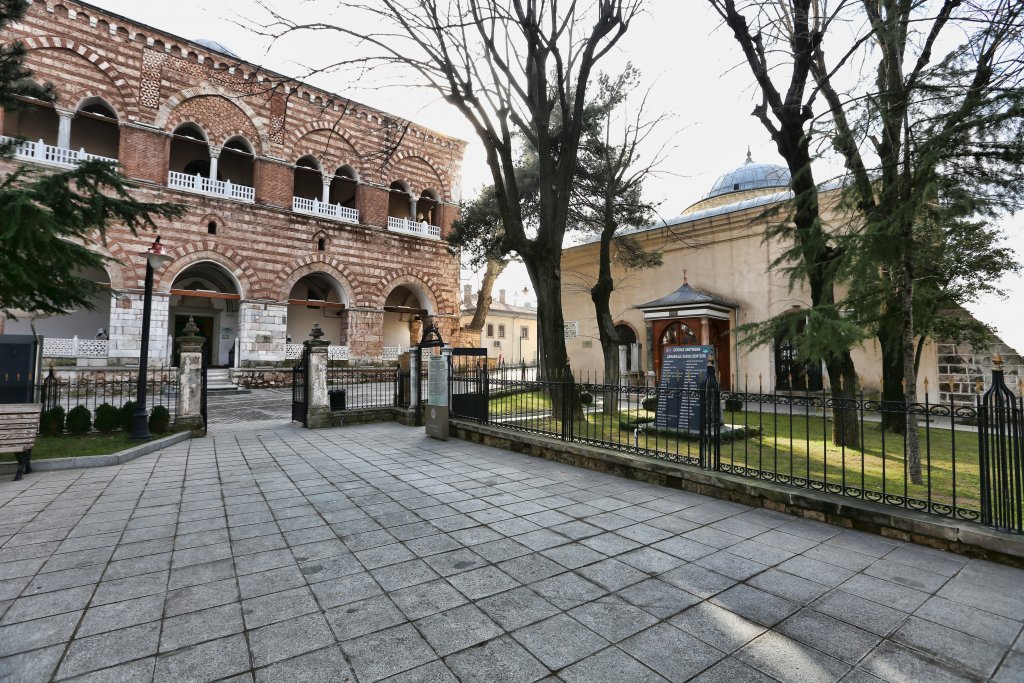
9. Step Back in Time: Explore the Charming Village of Cumalıkızık
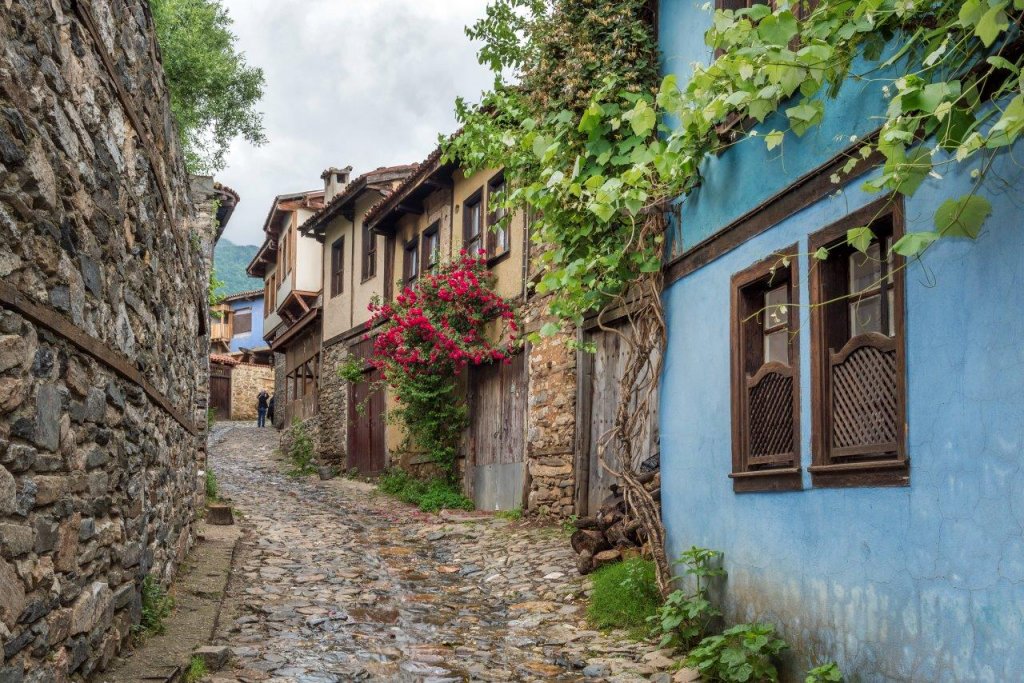
Discover the charm of Cumalıkızık Village, an enchanting tourist attraction nestled in the outskirts of Bursa, Turkey. It would be a perfect day trip from the town center.
Cumalıkızık Village is an early Ottoman era Endowment village located 12 km east of Bursa, on the Bursa-Ankara highway, north of Uludağ.
The name “Kızık” is mentioned in the 11th century in Divan-ı Lugat-it Türk, referring to Turkmen settlements in Anatolia and Northern Syria. Cumalıkızık is believed to have been established in the early 1300s, among the authentic and best-preserved villages among the Kızık Villages in Bursa.
It reflects the Ottoman strategy of first conquering the rural areas and then the cities to establish a secure hinterland for the army.
The village is an Endowment Village, meaning it belongs permanently to a public institution (complex) and serves the purpose of generating income for other complexes and the construction of the new city. Its establishment is part of the founding of Bursa as a capital.
The village has preserved its original plans, construction techniques, and atmosphere, providing a glimpse into the Early Ottoman Period. The surrounding land is still used for agriculture and forestry.
Cumalıkızık Village is included in the UNESCO World Heritage site declared in 2014.
You must visit to the village of Cumalıkızık to admire its charming collection of old houses, showcasing the captivating architectural heritage of the region.
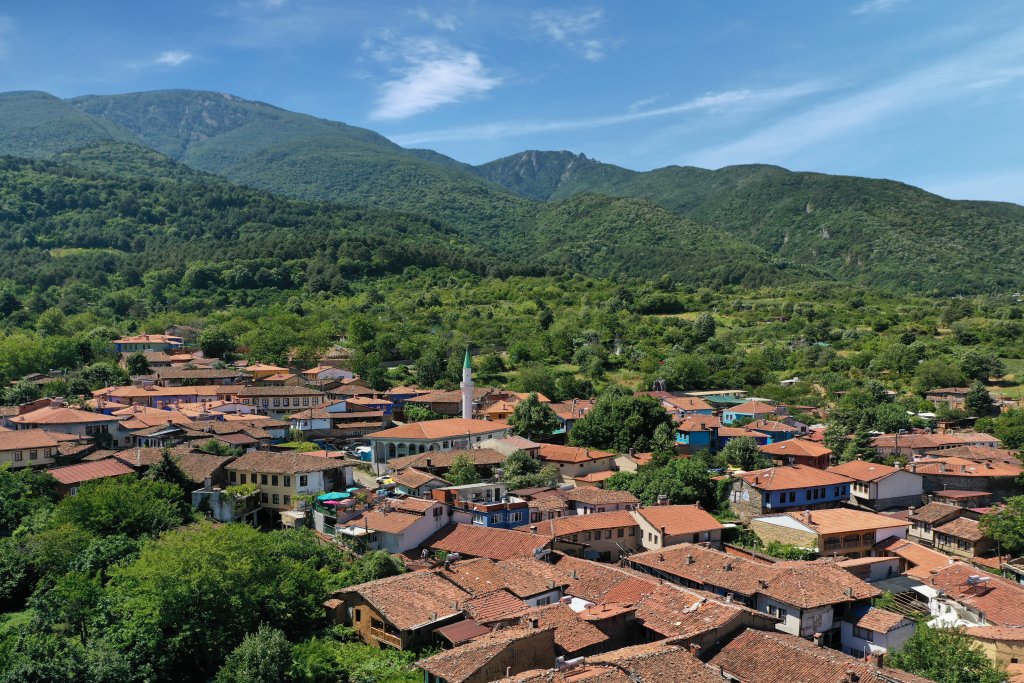
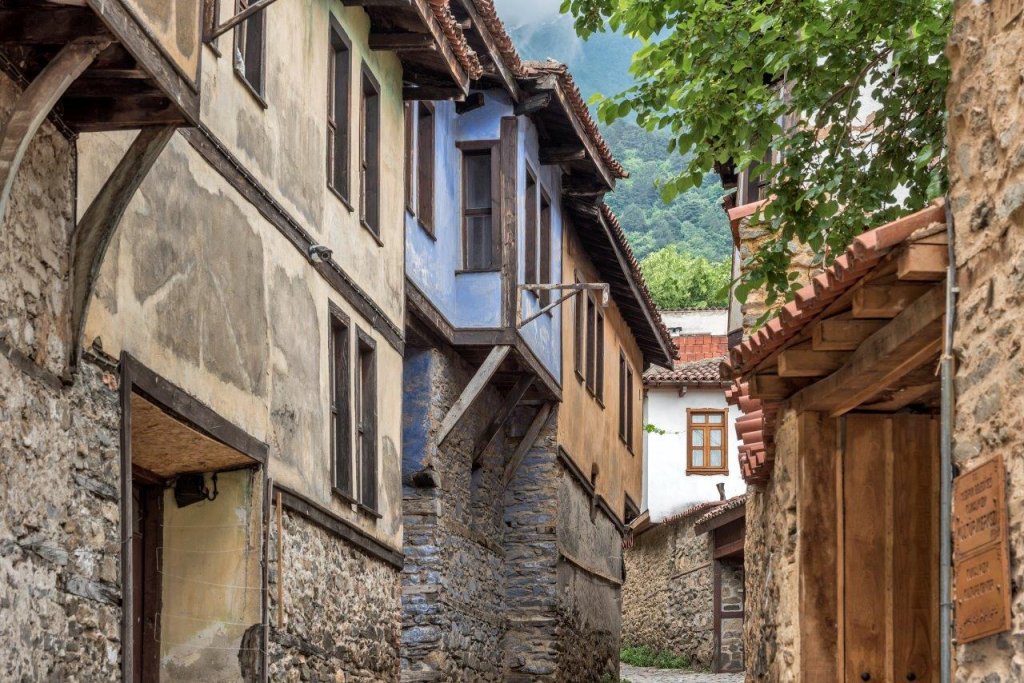
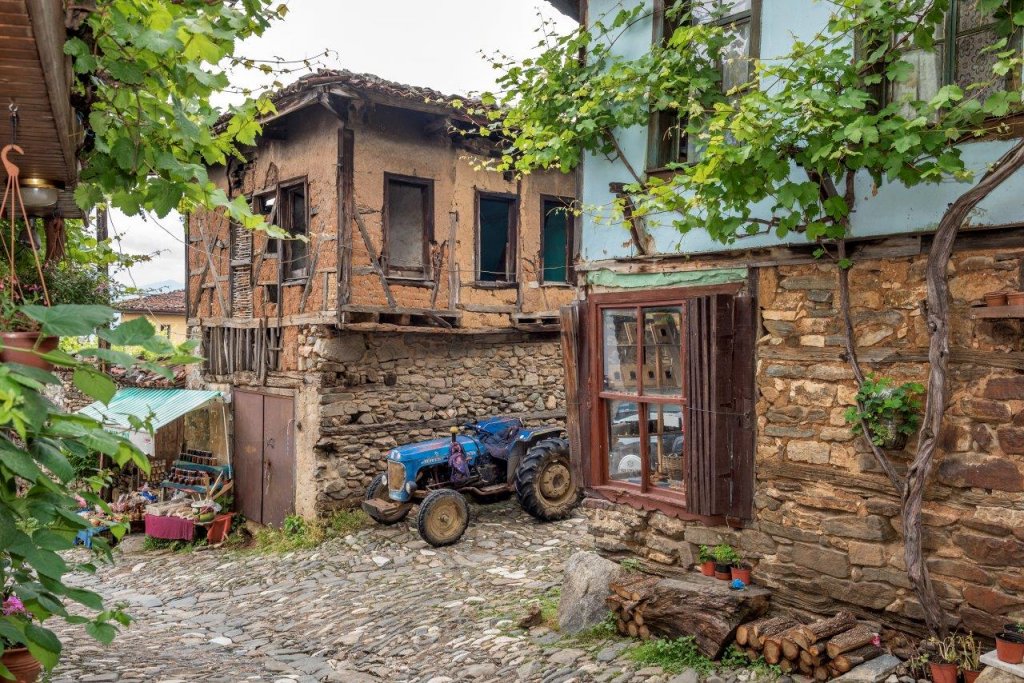
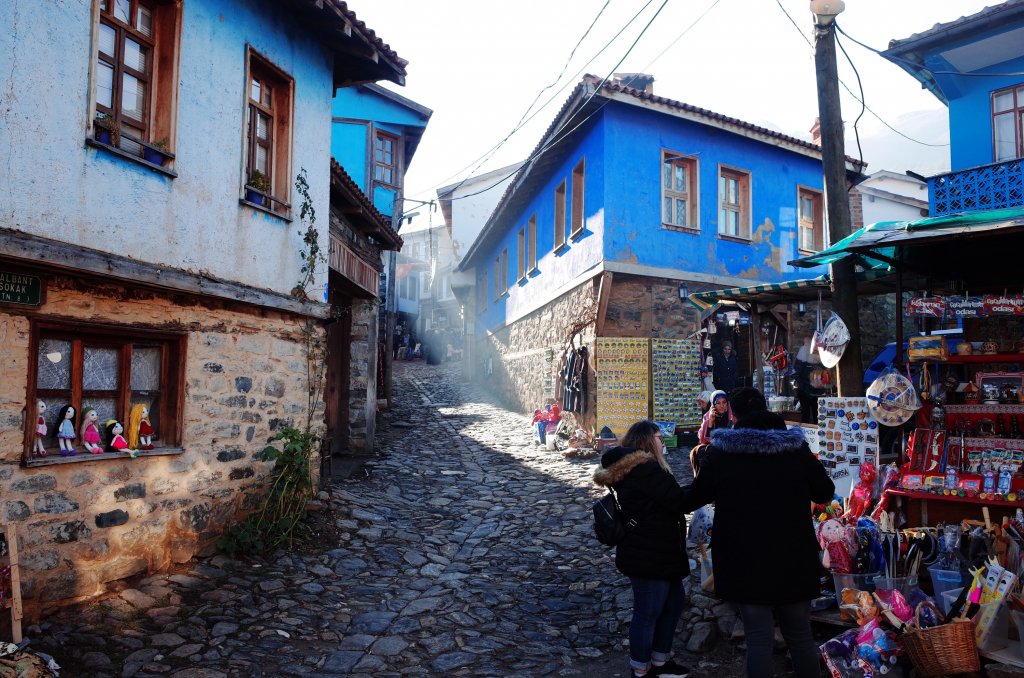
Sources
(The photos have been taken from the website mentioned above.)

